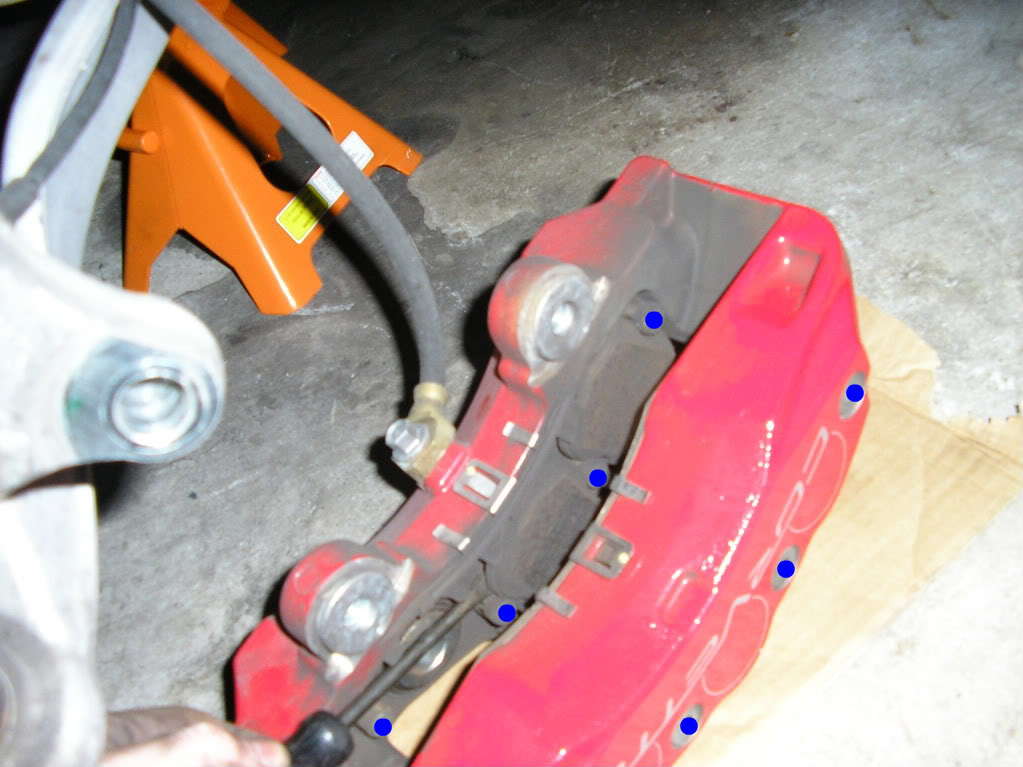C6 Corvette: How to Replace Front Brake Calipers
When you own a monster like the Corvette, you need the best brakes you can get. Here's how to change your brake calipers and keep your braking system running at its best.
This article applies to the Corvette C6 (2005-2013).
Properly functioning calipers are crucial to being able to stop properly. The purpose of the calipers is to apply the pressure to the brake pad and to push it against the rotor, so it allows you to slow down. If the caliper is hanging or just not working properly, it's best to replace it as soon as possible to prevent an accident. This article will cover how to replace the front calipers.

Materials Needed
- Brake hose fitting gasket (two per caliper)
- Jack
- Jack stand
- Tire iron
- Socket set
- Penetrating oil (PB-Blaster)
- Thread locker
- C-clamp
Step 1 – Remove the front wheel
First, you will need to remove the front wheel.
- Park on flat level ground.
- Set the parking brake.
- Block rear wheels.
- Using your tire iron, break loose the lug nuts.
- Jack up the car, so the tire is off the ground.
- Remove the lug nuts.
- Remove the wheel.
- Position jack stand under the lower control arm and then lower the car onto the jack stand.

(Related Article: How to Jack Up Your Vette - CorvetteForum.com)
Step 2 – Remove brake line
With the wheel off, you'll now be able to remove the calipers. It is suggested having some PB-Blaster or something similar handy because the bolts are on pretty tight.
- Check your brake fluid level. If it's above the midway point (between the low and full lines), you'll need to siphon some out until it's below that point. Otherwise, fluid will come out until it hits that point when you go to disconnect the brake lines. Take special care to not get brake fluid on any of your paint because it's extremely corrosive and will eat through it with ease.
- Remove the bolt labeled 1 in Figure 2. If you didn't lower the fluid amount to the midway point, the brake fluid will pour out now.
- Using a plug of some sort, plug the brake line as well as the caliper inlet port if you plan to reuse it to prevent any contamination.
- Discard the gaskets labeled 2. You'll need to replace these with new ones during install.

Step 3 – Remove the caliper
With the brake line out of the way, caliper removal is simple from here.
- Remove the two bolts marked by the red dots in Figure 3. You may need to use a penetrating oil to loosen them.
- You can now pull off the calipers. You may need to use a pry bar to get the leverage.

Figure 3. Caliper bolts. 
Figure 4. Caliper removal diagram.
Pro Tip
If you are removing the calipers to replace the pads, you'll want to do that now.
Step 4 – Brake pad removal (optional)
This step is only required if you are replacing the pads and re-installing the old caliper.
- Pry out all six mini brake pads out of the caliper (three per side).
- If you are installing one piece pads with the exception of CarboTech brand ones, remove the alignment pins marked by the blue dots in Figure 5.

Step 5 – Install new brake pads (optional)
If you've removed the calipers in the previous step or your new calipers didn't come with pads installed, you'll need to do this step.
- Compress the pistons to make installing the caliper back onto the rotor easier (only compress as far as needed to prevent any potential damage). If the brake line is disconnected from the caliper, this will push all the brake fluid out of the inlet hole. If the line is connected, it'll push the fluid back into the system and you'll want to remove the fluid reservoir cap. (Figure 6)
- The new brake pads will clip into place.

Step 6 – Install caliper
- Clean caliper threading holes and bolts.
- Apply a thread locker such as Loctite Blue to the bottom 2/3 of the bolt (opposite end of the head).
- Slide the caliper back onto the rotor. You may need to carefully compress the pads onto the pistons some more to allow clearance.
- Re-install the caliper bolts and torque to 162 lb-ft.
- Re-install the brake line, there should be a gasket on both sides of the brake line fitting. Torque to 30 lb-ft.
Step 7 – Finishing up
You'll now need to bleed the brakes. If you don't have a power bleeder, it is suggested getting an assistant to help you with this to prevent damaging the brake booster. Top off the brake fluid reservoir if it's not within the fill range. If you replaced the brake pads, you'll need to follow the manufacturer's instructions to properly seat them.
(Related Article: How to Bleed Your Brake System - CorvetteForum.com)
Related Discussion
- Changing Brake Pads On Stock Calipers - CorvetteForum.com






